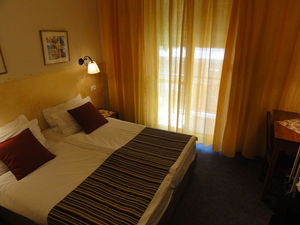Are you planning on starting a career in hotel sales? If so, you’re going to need to become familiar with revenue management and the mathematical calculations that go along with it. When I worked in the hotel industry, the calculations were one of the first things that I needed to learn in order to transition from a front desk clerk’s position into management. With that said, I thought that I would share a few of the calculations with those who may be contemplating a hospitality career. Here they are:
Occupancy Percentage
A hotel’s occupancy percentage is important to figure out because it represents the number of rooms sold during a select time period. It is often used in forecasting and marketing. When I was employed as a Director of Sales and Marketing, I used it to help determine whether or not the promotions and marketing strategies that I was using were working the way that I had hoped. The occupancy rate is calculated by dividing the number of occupied rooms into the number of available rooms. For example, if a hotel has 100 rooms and 90 of those rooms are occupied, the hotel is said to have a .9 or 90% occupancy percentage.
Multiple Occupancy Percentage
A hotel’s multiple occupancy percentage is also good to know. It is often used by both the housekeeping department and a hotel’s food and beverage divisions for forecasting revenues and ordering supplies. Some hotels may also use the percentage to evaluate possible expansion and remodeling initiatives. For example, if the hotel finds that they sell more double occupancy rooms that single occupancy rooms, they may want to convert their single occupancy rooms into doubles. It is calculated by dividing the number of guest rooms occupied by more than one person into the number of rooms sold.
Average Number of Guests Per Room Sold
The average number of guests per room sold is also used in forecasting revenues and ordering supplies. I would often use it in conjunction with the multiple occupancy percentage. It is calculated by taking the number of guests in the hotel and dividing it into the number of rooms sold. For example, if a hotel has 150 guests and 100 rooms sold, its average number of guests per room sold would be 1.5.
Average Rate Per Guest
The average rate per guest is calculated by taking the total rooms revenue for the day and dividing it into the number of guests. For example, if the hotel made $6,000 and had 50 guests in house, the average rate per guest would be $120. It is often used in budgeting applications, forecasting and the purchasing of supplies.
Rev Par
Based on my experience, Rev Par is crucial because it takes into account all revenue streams and as such provides a revenue benchmark for the entire hotel. It is also the calculation that I used the most often throughout my hotel career. It is calculated by taking the hotel’s total revenue and dividing it into the number of available rooms. For example, if the hotel’s rooms division and restaurant generate $7,000 in one day and the total number of available rooms is 100, the hotel’s Rev Par is said to be $70.
Average Daily Revenue
Like its name suggests, a hotel’s average daily revenue is used in revenue forecasting and rate setting. It is calculated by taking the day’s total amount of room revenue and dividing it into the number of rooms sold. For example, if a hotel made $4,000 in revenue and sold 50 rooms, its average daily rate would be $80.00.
Yield Statistic
A hotel’s yield statistic represents the difference between what was sold and what could have been sold. As such, it is an important indicator of the quality of the hotel’s sales agents as well as the public’s perceived value of the property. In my opinion, it is also useful in determining whether or not the hotel’s rack rate is unrealistic. The yield statistic is calculated by taking the actual rooms revenue figure and dividing it into the potential rooms revenue figure. For example, if a hotel has the potential to generate $10,000 in revenue but it only generated $5,000, its yield statistic would be .5 or 50%.
Source: Personal Experience
Killeen Gonzalez has a degree in hotel and restaurant management as well as marketing. She has since retired from the hospitality industry.
More from this contributor:
Profit Generating Tips for Restaurant and Lodging Owners
5 Social Media Management Tools for Small Business Owners
Snapshot of a Successful Motorcoach Day Trip Marketing Program
How to Get Your Barbecue Sauce onto Grocery Store Shelves



